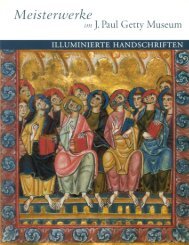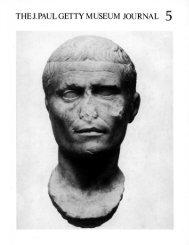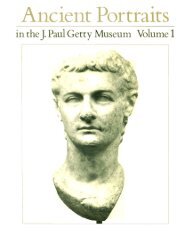<strong>The</strong> God Apollo, a Ceremonial Table with Griffins,and a Votive BasinCornelius C. VermeuleThree very different works of Greek art have come toMalibu together (figs. 1—3). <strong>The</strong> most reliable informationseems to indicate that they were found as a groupin ruins in a mound, probably in western Greek lands.<strong>The</strong> statue of Apollo has been carved from marblewhich certainly comes from Attica, and the two elegantobjects of furniture—a ceremonial table and a votivebasin—have been fashioned out of marble from theAegean Islands of Greece, not Thasos in the north butthe area of Paros or Naxos in the Cyclades.<strong>The</strong> purpose of this study is to argue that all threesculptures were fashioned about the same time, near theend of the fourth century B.C. or at the beginning of thethird, and that they were made or assembled as a cohesivegroup in antiquity. 1Furthermore, when consideredtogether, the subjects and iconographic details of thethree objects suggest connections between the Macedoniankingdoms after the death of Alexander the Greatand Megale Hellas, the Greek world in southern Italy.<strong>The</strong> powerful personality who linked these regions togetherat this time was Pyrrhus, King of Epirus(319—272 B.C.), who for a period before 283 B.C. controlledhalf of Macedonia and <strong>The</strong>ssaly. Shortly thereafter,he came to the southernmost part of Italy to helpTarentum in the struggle against the Romans.At Locri Epizephyrii, located on the ball of the footof the Italian "boot," in ancient Bruttium (Reggio Calabria),King Pyrrhus struck a silver didrachm that is, tomy mind, one small piece of evidence connecting thelekanis, or louter (basin), with the trapezophoros (tablesupport); after a few mythological and geographicalspeculations, this link can be made to extend to thestatue of Apollo. <strong>The</strong>se connections suggest that an importantperson in touch with both Macedonian and Italian-Greekaffairs, perhaps King Pyrrhus himself, dedicatedthis ensemble in a sacred area somewhere alongthe western coast of the Adriatic Sea.APOLLO<strong>The</strong> youthful god stands with his weight on the leftleg, the left hip thrown slightly outward (fig. 1). <strong>The</strong>right leg and right foot were slightly advanced. <strong>The</strong>reare remains of a griffin seated at the left foot, its rightwing curling up between the god's left hip and thecloak wrapped around his left arm. This cloak is drawnaround, and covers most of, the back; it hangs over theright shoulder with an extra fold. In his hair the godwears a fillet, flanked by braids. This fillet is tied with aknot at the back; the two ends lie over the carefullyarranged hair. At the brow, the hair is tucked under thefillet in such a way as to allow two curls to spiral downin front of the ears. 2Apollo's lowered left hand, perhaps holding an arrow,rested above the wings of the griffin, and the righthand, perhaps holding a bow, was raised and extended.Alternatively, the extended right hand may have held aAt the <strong>Getty</strong> <strong>Museum</strong> thanks are due to John Walsh, Director,Marion True, Curator, and Arthur Houghton, former AssociateCurator, for permission to publish these sculptures. Sandra KnudsenMorgan, former Editor, was, as she has been for well over a decade, aconstant source of help and inspiration. Jifi Frei was extremely helpfulwith scholarly ideas and general information at the time these sculpturesfirst came to notice. At the <strong>Museum</strong> of Fine Arts, Boston, JanFontein, Director, and colleagues in the Department of ClassicalArt—Mary Comstock, John Herrmann, Florence Wolsky, Emily Vermeule,and Michael Padgett—have been most supportive.1. <strong>The</strong>se sculptures were catalogued by the present writer as nos.8, 9, and 10 in Catalogue of a Collection of Greek, Etruscan and RomanAntiquities (Cambridge, Mass., 1984), when they were in private handsin New York and London. Thanks also are offered to the formerowners for help in studying the three sculptures, and other works ofart, over the past years.2. Accession number 85.AA.108. H (max.): 148 cm (58V4"); W(max. at the rib cage): 46 cm (Wis), (max. at plinth): 57.5 cm (22 5 /s");D (max. at the left side of the plinth between the griffin's forepaws):24.8 cm (9 3 A"). H (max. of plinth): 3 cm (IW).Greek marble with fine but evident crystals, in my opinion, probablyPentelic and surely from Attica. Remains of an iron dowel arefound in the rectangular hole below the cloak, against the right shoulder.<strong>The</strong> mark of a modern plow runs from below the right shoulderto the middle of the right thigh. <strong>The</strong> breaks are visible in the photographs.<strong>The</strong>re are no restorations. <strong>The</strong> surfaces of the flesh were wellfinished but were not highly polished. <strong>The</strong> same is true of the draperyor cloak, both front and back. Hair and diadem are less finelyfinished, save for the diadem in front which matches the flesh surfaces.<strong>The</strong>re are root marks and encrustation at various places over thegod, the griffin, and the plinth. See "Acquisitions/1985," <strong>The</strong> J. <strong>Paul</strong><strong>Getty</strong> <strong>Museum</strong> <strong>Journal</strong> 14 (1986), no. 6, p. 181.
28 Vermeulelibation dish (phiale) and the lowered left, the bow, oreven both a bow and an arrow. 3This impressive statue is neither a work of the periodbetween late Archaic and early Transitional Greeksculpture nor a sleek eclectic creation of the Pasiteleanperiod in Naples and Rome of circa 85 B.C. and later inthe first century. 4While incorporating memories of Atticand South Italian Greek sculpture at the time of thePersian Wars, the stance and the softened forms of thebody mark this carving as a work of the late fourthcentury B.C. or a generation later, influenced by the socalledPraxitelean traditions of Greek sculpture. <strong>The</strong>techniques of carving—the finishing in the hair, flesh,diadem, and drapery and the details of animal andplinth—as well as the simplified piecing with dowels,conform to practices of around 300 B.C. This Apollobelongs among the rare examples of so-called "Archaizing"Greek art of the period before the lateHellenistic age.Research over the past century, particularly since theFirst and Second World Wars, makes it evident that"Archaistic" Greek art began in the fifth or fourth century,rather than in the period of copyism in the firstcentury B.C. Modern terminologies ("Archaizing,""Archaistic," and "Lingering Archaic") are explained byB. S. Ridgway in <strong>The</strong> Archaic Style in Greek Sculpture. 5<strong>The</strong> <strong>Getty</strong> Apollo, by Ridgway's criteria, can be classedas "Archaizing." It is "a work of sculpture which belongsclearly and unequivocally to a period later than480 and which, for all its differences in plastic treatmentof drapery and tridimensionality of poses, retains a fewformal traits of Archaic style, such as coiffure, pattern offolds, gestures or the like." 6Unlike the Apollo from theHouse of Menander at Pompeii with its cold, polishedFigure 1. Statue of the god Apollo. Greek, circa320-280 B.C. Marble. H (max.): 148 cm(58 1 //); W (max. at the rib cage): 46 cm(18V8 W ); D (max. at the left side of the plinth):24.8 cm (9W). Malibu, <strong>The</strong> J. <strong>Paul</strong> <strong>Getty</strong><strong>Museum</strong> 85.AA.108.3. A precedent for the griffin as attribute and support placed closeto one leg is found in a statue of Dionysos with his panther positionedat the bottom of the drapery that falls from his right wrist; the sculpturewas found in a house at Priene. See <strong>The</strong>odor Wiegand and H.Schräder, Priene (Berlin, 1904), pp. 368-369, fig. 463.4. <strong>The</strong> truly Roman version of such a statue is the youthful Apolloin the Archaic style in the Museo Nazionale, Naples, from theHouse of Menander at Pompeii. See J. B. Ward-Perkins, A. Claridge,and J. Herrmann, Pompeii, A.D. 19 (Boston, 1978), vol. 2, no. 83, p.148. <strong>The</strong> archetype of the Apollo studied here was copied in Julio-Claudian times in the small marble statue in the Palazzo della Bancad'ltalia, Via Nazionale, Rome, showing that the original belonged tothe first years after, or, in Sicily, the last moments of, the Persian-Carthaginian wars. See E. Paribeni, "Di un nuovo tipo di Apollo distile severo," Antike Plastik 17, Teil 6 (1978), pp. 101-105, pis. 50-52.5. See Christine Mitchell Havelock, "Archaistic Reliefs of theHellenistic Period," AJA 68 (1964), pp. 42, 44, pi. 17, fig. 1, a relief ofHermes and the nymphs belonging to the fourth century B.C., circa320. See B. S. Ridgway, <strong>The</strong> Archaic Style in Greek Sculpture (Princeton,1977), pp. 303-319, and bibliography, pp. 320-322.6. Ridgway (supra, note 5), p. 303.








